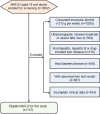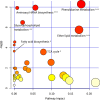Metabolic analysis of early nonalcoholic fatty liver disease in humans using liquid chromatography-mass spectrometry
- PMID: 33858428
- PMCID: PMC8050915
- DOI: 10.1186/s12967-021-02820-7
Metabolic analysis of early nonalcoholic fatty liver disease in humans using liquid chromatography-mass spectrometry
Erratum in
-
Correction to: Metabolic analysis of early nonalcoholic fatty liver disease in humans using liquid chromatography-mass spectrometry.J Transl Med. 2022 Jan 10;20(1):24. doi: 10.1186/s12967-021-03223-4. J Transl Med. 2022. PMID: 35012563 Free PMC article. No abstract available.
Abstract
Background: Nonalcoholic fatty liver disease (NAFLD) is a common metabolic disease that affects 20-30% of individuals worldwide. Liver puncture remains the gold standard for the diagnosis of liver diseases despite limitations regarding invasive nature and sample variability. It is of great clinical significance to find noninvasive biomarkers to detect and predict NAFLD.
Objective: The aims of this study were to identify potential serum markers in individuals with early-stage NAFLD and to advance the mechanistic understanding of this disease using a high-throughput mass spectrometry-based untargeted metabolomics approach.
Methods: One hundred and twelve patients with early-stage NAFLD aged 18-55 were recruited according to the guidelines. The control group included 112 healthy participants. The demographic, anthropometric, clinical and laboratory data of all participants were systematically collected. Serum samples were obtained after an overnight fast. The comprehensive serum metabolomic analysis was performed by ultra-performance liquid chromatography-Orbitrap mass spectrometry. The resultant data was processed by Compound Discover and SIMCA-P software to validate the potential biomarkers. Significantly altered metabolites were evaluated by variable importance in projection value (VIP > 1) and ANOVA (p < 0.01). Pathway analysis was performed using MetaboAnalyst 4.0.
Results: The liver function test of early NAFLD patients showed no statistical differences to control group (p > 0.05). However, obvious differences in blood lipids were observed between subjects with NAFLD and controls (p < 0.001). In total, 55 metabolites showed significant changes in experimental group were identified. The area under curve (AUC) values deduced by receiver operating curve (ROC) analysis indicated that these newly identified biomarkers have high predictability and reliability. Of these, 15 metabolites with AUC greater than 0.9 were of great diagnostic value in early NAFLD patients.
Conclusion: In this study, a total of 15 serum metabolites were found to strongly associate with early NAFLD. These biomarkers may have great clinical significance in the early diagnosis of NAFLD, as well as to follow response to therapeutic interventions.
Keywords: Biomarkers; Early diagnosis; LC–MS/MS; Metabolomics; NAFLD.
Conflict of interest statement
The authors declare that they have no conflict of interest.
Figures





Similar articles
-
Mass spectrometry-based untargeted metabolomics study of non-obese individuals with non-alcoholic fatty liver disease.Scand J Gastroenterol. 2023 Jul-Dec;58(11):1344-1350. doi: 10.1080/00365521.2023.2225667. Epub 2023 Jun 20. Scand J Gastroenterol. 2023. PMID: 37337892
-
Serum metabolome alterations in patients with early nonalcoholic fatty liver disease.Biosci Rep. 2022 Oct 28;42(10):BSR20220319. doi: 10.1042/BSR20220319. Biosci Rep. 2022. PMID: 36124945 Free PMC article.
-
A metabolomics approach to the validation of predictive metabolites and phenotypic expression in non-alcoholic fatty liver disease.Life Sci. 2023 Jun 1;322:121626. doi: 10.1016/j.lfs.2023.121626. Epub 2023 Mar 31. Life Sci. 2023. PMID: 37003543
-
Current and Emerging Biomarkers and Imaging Modalities for Nonalcoholic Fatty Liver Disease: Clinical and Research Applications.Clin Ther. 2021 Sep;43(9):1505-1522. doi: 10.1016/j.clinthera.2021.07.012. Epub 2021 Aug 13. Clin Ther. 2021. PMID: 34400007 Review.
-
[Research progress of omics biomarkers for nonalcoholic fatty liver disease].Zhonghua Gan Zang Bing Za Zhi. 2021 Jun 20;29(6):604-608. doi: 10.3760/cma.j.cn501113-20200708-00382. Zhonghua Gan Zang Bing Za Zhi. 2021. PMID: 34225440 Review. Chinese.
Cited by
-
Oncohepatology: Navigating liver injury in the era of modern cancer therapy.World J Hepatol. 2025 Jun 27;17(6):106932. doi: 10.4254/wjh.v17.i6.106932. World J Hepatol. 2025. PMID: 40606932 Free PMC article. Review.
-
Correction to: Metabolic analysis of early nonalcoholic fatty liver disease in humans using liquid chromatography-mass spectrometry.J Transl Med. 2022 Jan 10;20(1):24. doi: 10.1186/s12967-021-03223-4. J Transl Med. 2022. PMID: 35012563 Free PMC article. No abstract available.
-
Defining the Scope of Exposome Studies and Research Needs from a Multidisciplinary Perspective.Environ Sci Technol Lett. 2021 Oct 12;8(10):839-852. doi: 10.1021/acs.estlett.1c00648. Epub 2021 Sep 7. Environ Sci Technol Lett. 2021. PMID: 34660833 Free PMC article. Review.
-
A UPLC-MS/MS method for simultaneous determination of arachidonic acid, stearic acid, and related endocannabinoids in human plasma.Heliyon. 2024 Mar 21;10(7):e28467. doi: 10.1016/j.heliyon.2024.e28467. eCollection 2024 Apr 15. Heliyon. 2024. PMID: 38560270 Free PMC article.
-
Investigation of the mechanism of Buyang Huanwu decoction in improving learning and memory impairment in Alzheimer's disease mice based on lipidomics.J Nat Med. 2025 May;79(3):568-590. doi: 10.1007/s11418-025-01890-x. Epub 2025 Apr 7. J Nat Med. 2025. PMID: 40195204 Free PMC article.
References
-
- Zhou J, Zhou F, Wang W, et al. Epidemiological Features of NAFLD From 1999 to 2018 in China. Hepatology. 2020;71(5):1851–1864. - PubMed
-
- Liu CJ. Prevalence and risk factors for non-alcoholic fatty liver disease in Asian people who are not obese. J Gastroenterol Hepatol. 2012;27(10):1555–1560. - PubMed
Publication types
MeSH terms
Substances
LinkOut - more resources
Full Text Sources
Other Literature Sources
Medical

